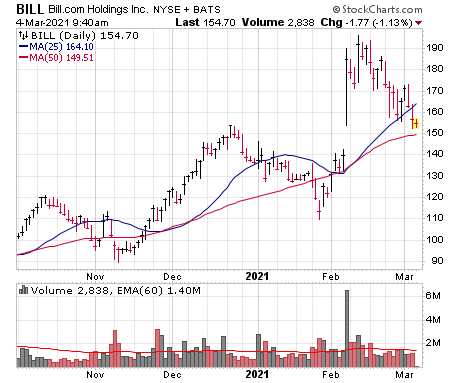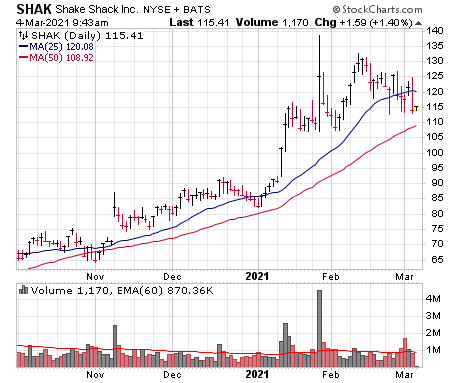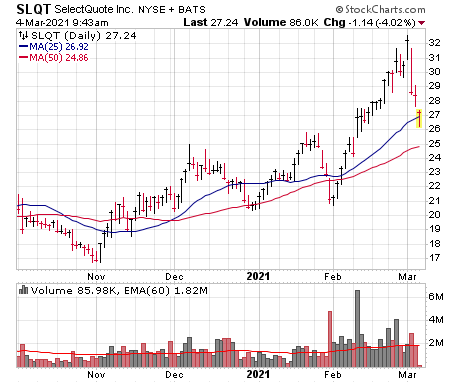It’s been a while since my last Cabot Wealth Daily column, as the powers that be (Chris Preston) gave me February off due to an extra webinar and some vacation time, so I have a lot to say. I’m going to get to the market, of course, and if you want to skip ahead to that, feel free. But first I wanted to quickly cover a couple of the most common questions I’ve been getting in recent weeks, starting with a frequent concern about the capital gains tax.
Don’t Fear the Capital Gains Tax
The first has to do with capital gains taxes, which always comes up when (a) people have a lot of unrealized capital gains and (b) many stocks begin to act funky. Is it worth it to take some profits, or better to give things more room to run in order to “avoid” the tax man for a while longer?
Let me say at the outset that I am not a tax expert, so if you have any real questions, ask your accountant or someone who knows more about the ins and outs of the subject.
[text_ad]
However, when it comes to investing, my biggest thought when it comes to the capital gains tax is: Factor it into your plan ahead of time, at least to some extent. When it comes time to sell (or not), you want to base it on factors that count—things like the action of the stock, the market, the sector, the company’s growth trajectory, etc. Once you start introducing other outside factors (like wanting money for a vacation or avoiding taxes), odds are your decision making will (in general) become less accurate.
Instead, it’s a good idea to consider Uncle Sam’s likely cut ahead of time in terms of your position sizing. For instance, if the vast majority of your trades are short-term (less than one year), and the tax rate on those trades is 30% (pulling this number out of thin air), that means that for every $1,000 you make or lose, “only” $700 of it is going into/coming out of your pocket. (Of course, this assumes that, over time, you’ll make money in the market, and I assume that’s a safe assumption for our subscribers!)
Thus, knowing this, you can increase your initial position size a bit if you want to “factor in” the tax hit ahead of time.
I’m not making any specific proposals, and to be absolutely clear, you don’t want to go crazy on your position size even factoring in taxes—if you buy too much, you’ll have a hard time playing out that position over time. But the overarching idea is to give some thought to the capital gains tax as part of your plan—that way you don’t have to agonize about it when the time comes to act on the sell side.
3 Pointers for Using Trailing Stops
Another popular question of late concerns trailing stops—obviously, the market has seen lots of wild action since late July, with many leading stocks getting tossed around 15% to 20% in a span of days. That’s caused some stops to be tripped, which may prove to be a good thing if the market keels over from here, but still has many wondering if they can improve their stop placement.
There’s no one best way to trail stops, but here are a couple of pointers that have worked well for me:
-Try to avoid a fixed percentage trail (15% off the high, etc.) for all positions—each stock is different, with some volatile and jumpy and others calm and collected. One-size-fits-all stops will usually leave you wanting.
-Consider taking some partial profits on the way up. Called “offensive” selling, shaving off a few shares when a stock has run for a few weeks or months and is extended to the upside can give you some staying power for the remaining chunk.
-In concert with some offensive selling, you can consider what I call a “tight to loose” approach to stops—start out with a tight-ish loss limit (say 10% to 12%, on average), but as you develop a profit (and especially after you’ve taken a chip or two off the table), you can loosen that out.
For instance, let’s say you bought a stock at 100 and had an initial stop at 90 (10 points), just to use round numbers. Now, over a couple of months, let’s say the stock has a good run to 130 and you sell some (one-quarter to one-third of your shares). But instead of trailing your stop higher in lockstep, you can loosen it out—while the stock rose 30 points, maybe you hike your stop only 15 to 20 points. Thus, you’re booking some profit (by selling a chunk), but also giving your remaining shares room to rest/shakeout.
Obviously, at some point, you would stop loosening the stop—I like to use a 200-day moving average for really big winners—but the point is to use the profit cushion to your advantage by giving your position more room to maneuver, which in turn gives you more of a chance of riding out an intermediate- to longer-term winner.
3 Growth Stocks Hanging Tough Amid the Selloff
OK, now for the current market. At heart, I’m a trend follower, and my trend-following indicators are still positive, so I’m constructive on the overall bull market; especially looking at the big picture, I think last November’s kick-off bodes well for down the road.
Near-term, though, I have to admit I’m less sanguine for a few reasons when it comes to growth stocks. First, after a big run, we’ve now seen many weeks of violent up-down-up-down action, which by definition means the bulls and bears are starting to fight it out. At the very least that’s a change in character, and oftentimes it can be a sign of distribution.
Second, many secondary measures are also flashing yellow—investor sentiment remains in the stratosphere, while recently, the number of stocks hitting new 52-week lows has begun to pick up, a sign of expanding selling pressures.
And third, we’re “losing” more and more growth stocks and sectors, with speculative areas (marijuana stocks, electric vehicle stocks, alternative energy stocks) cracking while some growth leaders (like Tesla (TSLA)) have finally dove below their 50-day lines.
So I’m super bearish, right? No. As I just wrote, longer-term, I’m very optimistic, and none of the action I’ve seen of late is big-picture negative—it’s more about many stocks having come a long way and looking tired. That’s no reason to be complacent, as it’s possible some leaders may need a prolonged correction and consolidation, but my thought right now is to take things on a stock-by-stock basis. If you own a bunch of cyclical-type stocks, you’re probably doing fine and don’t have to do much, but if you bought some things in the past few weeks and have a handful of losses, don’t let them get away from you.
On the buy side, it’s hard to find many low-risk entry points given that most growth stocks are flopping around 4% to 6% every day or two. But I see three names to at least keep on your radar.
The first is Bill.com (BILL) which has a great story but has always had big moves up and down, and we’re seeing plenty of that lately, with a giant earnings gap in early February followed by a huge decline since. It’s looking ragged like most growth stocks, but as it fills the earnings gap, it could find support, and it has a history of ugly declines (see mid-December through late January) before picking itself up again.
Shake Shack (SHAK) is a big cookie-cutter story (40% increase in the restaurant base during the next two years) that’s also likely to benefit from the return to economic normalcy. The stock is holding pretty well in here despite a convertible bond offering.
And finally, take a gander at SelectQuote (SLQT), which is another stock that came public last year, went through the wringer for a few months, but has now shown some accumulation. And why not, given its triple-digit sales and earnings growth and leading position in its huge market? The stock has been hit this week with the market and a share offering, but the overall chart isn’t awful at all; it’s one I’m watching closely.
There are many other names, too, so again, it’s not like the market is in dire straits. If the market straightens out, I still think there could be a good number of fresh growth stocks to sink our teeth into. But for now, I think the onus is on the bulls to settle things down and prove the recent yellow flags aren’t the start of something more serious.
[author_ad]




